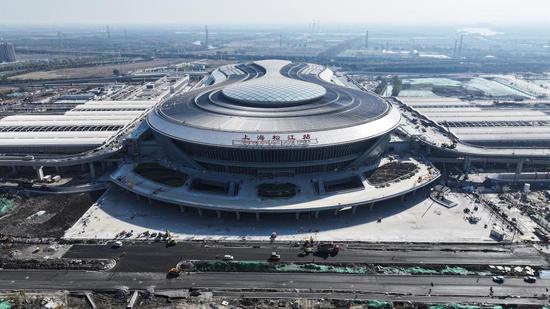The property market has exhibited clear signs of bottoming out and stabilizing due to a recent forceful policy package aimed at easing access for and reducing the financial burden on homebuyers, although dedicated efforts are still needed for a solid recovery next year, officials and analysts said.
Accelerating the redevelopment of urban villages and dilapidating housing, and increasing the supply of government-subsidized housing will be high on the agenda next year to put the real estate industry on a more sustainable footing, they added.
Sales of new commercial housing registered consecutive monthly increases in October and November, rising on a year-on-year as well as a month-on-month basis, according to the annual work conference of the Ministry of Housing and Urban-Rural Development held from Tuesday to Wednesday.
This is a clear indication that the government's targeted policy steps have helped arrest the downward spiral in the property sector and underpinned its gradual recovery, according to the meeting.
In November, policymakers in major cities like Beijing, Shanghai, and Shenzhen introduced new preferential tax policies aimed at lowering transaction costs for homebuyers.
This followed a series of policy changes introduced in September, which included reducing the minimum down payment ratio to 15 percent across all housing categories and relaxing home purchase restrictions.
The government's policy focus in the next phase will shift toward two key areas — promoting demand and optimizing supply, as outlined during the meeting of the of Ministry of Housing and Urban-Rural Development.
On the demand side, the measures are expected to center around expediting the redevelopment of urban villages and dilapidated housing, as well as further optimizing purchase restrictions in first-tier cities, said Huang Yu, executive vice-president of China Index Academy, a property research institution in Shanghai.
Chinese authorities rolled out an initiative to renovate 1 million more homes in urban villages and dilapidated housing in October, and later expanded its support for urban village redevelopment to nearly 300 cities from the previous 35 major ones.
Drawn from the experience of 2015 to 2017, when similar redevelopment initiatives were implemented in rundown urban areas, the additional 1 million units of urban village housing could lead to the sale of nearly 10 million square meters of new residential properties, according to China Real Estate Information Corp.
This influx of new demand will provide a much-needed shot in the arm for the real estate sector, to not only improve people's living conditions, but also solidify the current positive momentum, Huang said.
In tandem with its initiatives to boost housing demand, the government is also intensifying its focus on the supply-side of the real estate equation, with a particular emphasis on accelerating the clearance of existing inventories, analysts said.
Local governments are encouraged to use funds from special-purpose bonds to reclaim and acquire idle land, while the relending facility dedicated to purchasing unsold commercial homes as affordable housing will be further enhanced, said Yan Yuejin, deputy head of the Shanghai-based E-House China R&D Institute.
However, only Shanghai and Zhejiang's provincial capital Hangzhou have managed to bring their inventory levels down to a healthy clearance period of less than 10 months, data from the China Index Academy showed. In contrast, many other cities, particularly second-tier cities are struggling with inventory overhang that can take over 20 months to clear, according to the academy.


















































 京公网安备 11010202009201号
京公网安备 11010202009201号